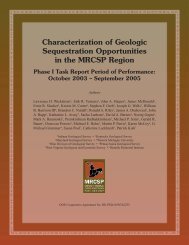Unraveling the stratigraphy of the Oriskany Sandstone: A necessity ...
Unraveling the stratigraphy of the Oriskany Sandstone: A necessity ...
Unraveling the stratigraphy of the Oriskany Sandstone: A necessity ...
You also want an ePaper? Increase the reach of your titles
YUMPU automatically turns print PDFs into web optimized ePapers that Google loves.
Figure 6. Map <strong>of</strong> <strong>the</strong> North<br />
Summit storage field showing<br />
<strong>the</strong> location <strong>of</strong> <strong>the</strong> G.E. Klayer 1<br />
and R.H. Heyn wells.<br />
as 14% (Carter and Kostelnik, 2008). The Dho play<br />
was fur<strong>the</strong>r evaluated using thin sections and core descriptions<br />
from <strong>the</strong> R.H. Heyn 1 well in Fayette County,<br />
Pennsylvania. We collected eight samples for thin<br />
section, SEM, and EDS analysis and conducted standard<br />
core analysis on two samples from <strong>the</strong> coarsest<br />
zone in <strong>the</strong> sandstone interval.<br />
Core and Petrographic Data<br />
In <strong>the</strong> R.H. Heyn well, <strong>the</strong> <strong>Oriskany</strong> occurs from 6824<br />
to 6930 ft (2080 to 2112 m). The core is missing from<br />
196 Sequestration Potential <strong>of</strong> <strong>the</strong> <strong>Oriskany</strong> <strong>Sandstone</strong><br />
6842 to 6848 ft (2085 to 2087 m) and 6858.2 and<br />
6863.4 ft (2090.3 and 2092 m), which yields a thickness<br />
<strong>of</strong> 88 ft (27 m). Based on <strong>the</strong> gamma-ray response,<br />
<strong>the</strong> cleanest <strong>Oriskany</strong> <strong>Sandstone</strong> zone occurs between<br />
6848.5 and 6855 ft (2087.4 and 2089 m). The <strong>Oriskany</strong><br />
in <strong>the</strong> North Summit Storage pool is a calcareneous sandstone<br />
(Pettijohn et al., 1987) composed <strong>of</strong> 30 to 40%<br />
clastic material and 60 to 65% carbonate components<br />
(Figure 7). The most common fossil allochems are brachiopods<br />
and mollusks, but o<strong>the</strong>r fragments, including<br />
trilobites and echinoderms, are also present. The largest<br />
fossil fragments, 0.12 to 0.16 in. (3 to 4 mm) in length,





